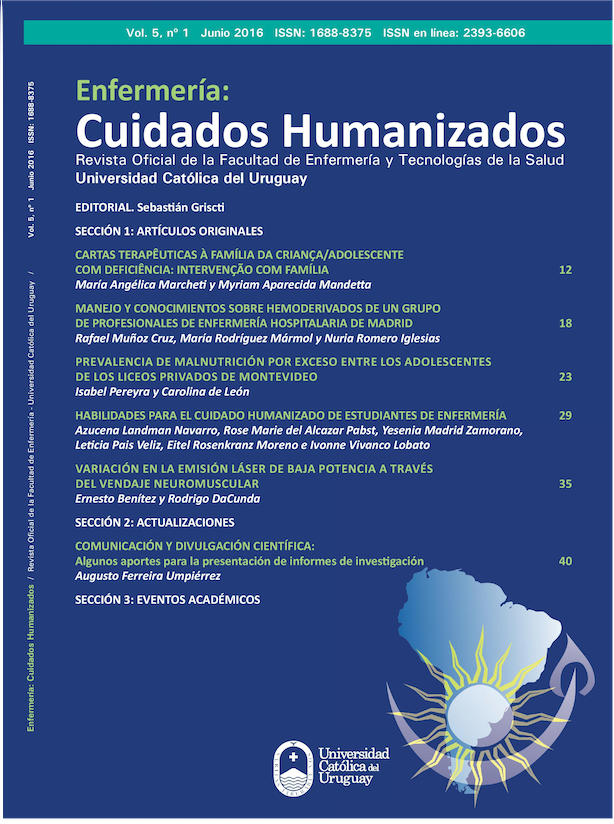VARIATION IN LOW POWER LASER EMISSIONS PASSING THROUGH KINESIO TAPING
DOI:
https://doi.org/10.22235/ech.v5i1.1191Keywords:
Physical Therapy Specialty, Lasers, Low-Level Light Therapy, Muscle Tonus.Abstract
The Kinesio taping is a technique used in physical therapy, where therapy objectives are achieved by means of applying elastic tapes with special features that adhere to the skin and are not removed for five days. These applications may coexist with other treatments, like physical agents and manual therapies. Low power laser therapy is a treatment that provides great benefits in tissue regeneration as well as in alleviating painful processes. It consists of the application on the skin of a light beam with special wavelength characteristics, right on the injured area. Laser effects could be added to those obtained by the Kinesio taping, but there is no information about the interaction of these two treatments, and whether or not there is an effective passage of the laser emission to the patient through the taping. This is the starting point for performing the following work, where the amount of laser light passing through the dressing is measured in mill watts. The results show a large drop in the energy that passes through the bandage, which depends on the color and the tension at which the tape is applied. The application of laser on Kinesio taping has no risk, but the power reduction shown in this work is significant. The conclusion is that insufficient doses are being applied, wearing out the equipment with few real effects on the patient. There are no studies on results when using these two therapeutic agents combined; therefore it is recommended to do further research on the interactions between these techniques to justify their use and their therapeutic effectiveness.
Downloads
References
(1) L. Espejo, M.D. Apolo. Revisión bibliográfica de la efectividad
del kinesiotaping. Rehabilitación. 2011;45 (2): 148– 158.
(2) Tsai H. et all. Could Kinesio tape replace the bandage in decongestive lymphatic therapy for breast-cancer-related lymphedema? A pilot study. Support Care Cancer; 2009: 17:1353–1360.
(3) O. Kaya Kara, et all. The effects of Kinesio Taping on body functions and activity in unilateral spastic cerebral palsy: a single-blind randomized controlled trial. Developmental Medicine & Child Neurology 2015, 57: 81–88.
(4) Camerota F. et al. Neuromuscular taping for the upper limb in Cerebral Palsy: A case study in a patient with hemiplegia. Dev Neurorehabil, Early Online: 2013, 1–4.
(5) Kumbrink B. K Taping-An Illustrated Guide. Berlin: Springer; 2012.
(6) Melis M. et al. Low Level Laser Therapy for the Treatment of Temporomandibular Disorders: A Systematic Review of the Literature. Cranio 2012; 30:304-12.
(7) Leal E. et al. Adjunctive use of combination of superpulsed
laser and light-emitting diodes phototherapy on nonspecific knee pain: double-blinded randomized placebo-controlled trial. Lasers Med Sci; 2014: 29:1839–1847.
(8) Nascimento D. Efeitos da irradiação com o laser hene 632.8nm sobre a cicatrização de feridas em ratos. Maringá; 2006: 5: (2): 229-235.
(9) Gur A. et all. Efficacy of 904 nm Gallium Arsenide Low Level Laser Therapy in the Management of Chronic Myofascial Pain in the Neck: A Double-Blind and Randomize- Controlled Trial. Lasers Surg Med; 2004: 35:229–35.
Downloads
Published
How to Cite
Issue
Section
License
Copyright (c) 2016 Enfermería: Cuidados Humanizados

This work is licensed under a Creative Commons Attribution 4.0 International License.

















